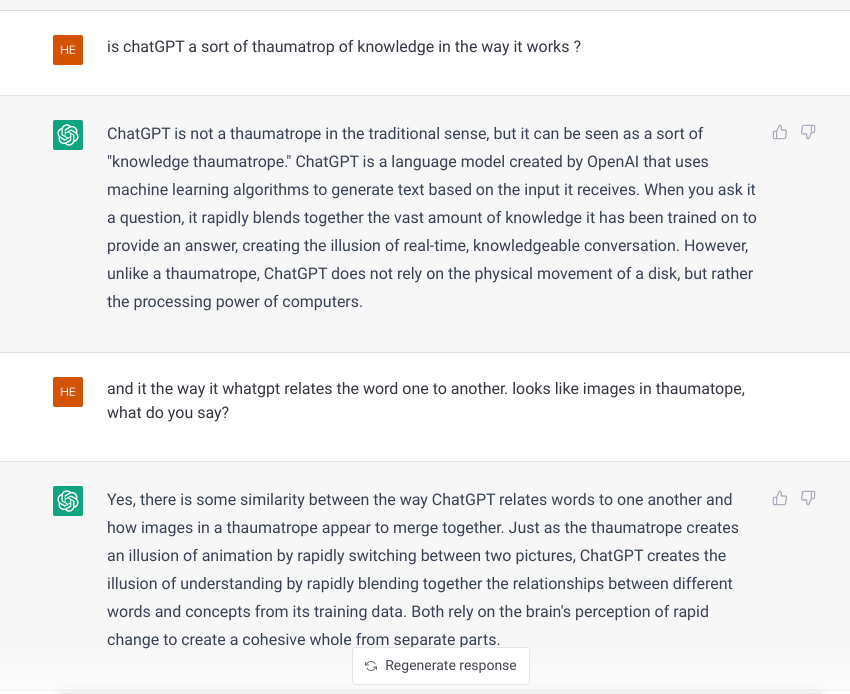Hervé MARY is CEO of MARYLINKa pioneer in Augmented Collaborative Innovation. He explains how ChatGPT is revolutionizing collaborative innovation, and how MARYLINK platforms are harnessing its potential to boost organizational innovation.
How do you see ChatGPT's benefits for organizations?
ChatGPT is the talk of the town. ChatGPT codes, does homework for students, . It can write a song, a poem or a personalized, detailed "lawyer's letter" to your noisy next-door neighbor!
There's no shortage of examples, and it does all this and more with a disconcerting level of quality.
So at this stage, is it still a gadget for organizations?
A grotesque Parrot limited to small individual tasks?
He's a creative person, but can he be effective and efficient enough to bring value to a complex innovation process?
ChatGPT sometimes talks nonsense! No ?
There are many criticisms of ChatGPT. These criticisms are legitimate. But they miss the essential point.
Some write articles that only try to explain that it's commonplace. That innovation is limited. That it's not a breakthrough.
And many point out the sometimes comical weaknesses. It's become a game, almost viral...
For example, He'll argue, with conviction that chicken eggs are naturally more fragile than... cow eggs! When everyone knows that it's actually the other way around 🙂
Make no mistake. It's not a gadget. a veritable revolution. Not an incremental innovation. More than a breakthrough, it's a disruptive innovation. And even more than that...
This will change the way we work as a group.
But beyond that, it will gradually be invited, or almost inevitably invite itself, into the very heart of value creation in organizations: it will revolutionize our ability to innovate as a group, in the long term...
What makes ChatGPT so effective?
Despite his youth, he's already able to think on his feet.
He doesn't think. He has no opinions, no feelings. He's not really capable of them. And that's a good thing.
But he is capable of thinking, in multiple ways, in series on a precise subject. Or to link a concept to parallel subjects with disconcerting ease. And in the end, that's what's most astonishing.
He doesn't think, but he can Think. In the etymological sense, i.e. "to bend backwards, to curl; to bring back" He is able to fold and bend his billions of pieces of knowledge with incredible agility to present them in a new light.
Doesn't ChatGPT run the risk of replacing employees?
It does not replace humans! It considerably enhances their cognitive abilities!
Humans are in fact able to distinguish a large number of nuances thanks to their consciousness and their ability to think through several prisms. Humans have a unique sensory perception.
It's as if we humans were endowed with the ability to distinguish the color nuances of an image, or of several images. With subtle gradations that the machine won't see.
Mais notre faculté de visualisation en “2D” est limitée par rapport à celle des machines.
ChatGPT doesn't have this sensitivity. It doesn't nuance much, it's 12 levels of gray.
But he's also able to think in 3D!
Il peut “réfléchir en 3D” ? C’est-à-dire ?
It is capable of bringing to light facets unexplored by the human mind.
Obviously, the human needs to be able to propose the right angles of attack or prompts, at the right moment in the conversation with chatGPT, but that's another story...
Furthermore, machines can process and visualize images faster and more efficiently than humans.
Ask him to add 10 related ideas to a single idea and he'll do the job... For us humans, it's complicated to be able to generate so many different ideas. We don't have the ability to put our mental images into perspective so quickly.
For him, it's a piece of cake! He loves it, he can do it without getting tired. For us, it's exhausting.
ChatGPT est programmé en cela pour être un penseur “outside the box” très naturel. Il permet de fournir un nombre quasi illimité d’images mentales !
Vous faites souvent référence au concept de “thaumatrope”, pourriez-vous nous en dire plus ?
Whereas our human mind spends a great deal of time studying each mental image in all its nuances, ChatGPT is able to associate a very large number of images in record time and paste them one after the other in a logical fashion. The result is a coherent film.
That's why, intuitively, I see him as a thaumatrope knowledge.
J’ai donc interroger CHatGPT à ce sujet. Il me l’a confirmé. Il ne “comprend rien au film de ce qu’il raconte” comme dirait ma fille, mais en reliant un grand nombre de mots (ou d’images dans notre analogie) de façon logique, le cerveau humain lui, y verra un film cohérent et exploitable.

in this way, he is able to unfold a new film in a matter of seconds, with different scenarios, different contexts, different narrators...
Bon, c’est encore balbutiant, à la sauce “the artist”, du cinéma des premières heures, muet, en noir et blanc avec des sous titres de précautions omniprésents.
Mais pour faire “tourner” des idées, c’est largement suffisant et performant.
What skills do employees need to use ChatGPT?
No special skills required. It's very simple. Just tell them what ChatGPT can and can't do. And give them a few tips on how to use prompts in their professional environment.
In my opinion, le “prompt” constitue la nouvelle frontière de la créativité. To find the right angle, you need to know how to ask the right questions, the right prompts as the neo-specialists say.
Although it thinks in 3D, it is not yet capable of deciding for itself to present the object in a particular way, so that its most relevant or creative facets come to the fore.
It's up to you to manipulate the object. It's as if you were using language to operate an object in the hand of an articulated robot. But as you've seen, this robot understands everything you ask it to, and in your own vocabulary.
In any case, the subject of skills is particularly interesting. In our initial tests, we found that the interface engages more and in a much broader way. In fact, using a collaborative innovation platform with a dialogue tool like ChatGPT makes it possible to value employees' experience and creativity, even if they have difficulty expressing themselves orally or in writing!
In conclusion, what do you see as the role of conversational agents like ChatGPT for organizations looking to innovate?
En guise de conclusion, je dirais que ChatGPT n’est certes pas parfait. On ne peut pas lui faire confiance pour du « fact checking ». Il se la “raconte un peu en hallucinant” souvent… par ailleurs, il sera un coéquipier, encore un peu trop sûr de lui et un peu “pipelette”.
But for brainstorming and scenario planning, it's perfect!
Mais pour faire bouger les lignes, et faire “tourner” une idée sur plusieurs dimensions, c’est un outil inédit, unique, performant, à très forte valeur ajoutée.
Despite this, it's very economical. You can start using it right away, while maintaining a high level of interaction with humans. And that's where he'll perform best. Don't expect him to come up with the idea of the century all by himself!
Mais intégré dans le bon outil d’innovation, qui lui permet de s’exprimer, tout en laissant l’humain en responsabilité, c’est un “sparring partner” incontournable.
All that remains is to find the right software suite that exploits these capabilities with the best possible integration within an innovative organization.
That's just what we do at MARYLINK 🙂



